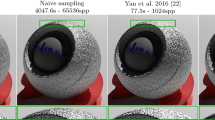Abstract
We analyse specular highlight modelling using microfacet-based physics illumination models. The ability to perform effective modelling is shown to depend on the ratio of the quantisation noise, ε, in the normal data to the object’s surface roughness parameter, m. We characterise how the accuracy degrades with increasing normal vector noise, when fitting is done in the Least Mean Squares sense. We show that it is not possible to accurately characterise sharp specular highlights, unless ε is very much less than m, and give examples of the practical implications of this theoretical result. We observe that the recently reported frequency-domain approaches can obscure this problem. We also present a novel characterisation of the importance of the geometric attenuation term in the microfacet models.
Similar content being viewed by others
References
Ashikhmin, M.: Distribution based BRDFs. http://jesper.kalliope.org/blog/library/dbrdfs.pdf (2006)
Blinn, J.F.: Models of light reflection for computer synthesized pictures. In: Proc. SIGGRAPH, pp. 192–198 (1977)
Cook, R.L., Torrance, K.E.: A reflectance model for computer graphics. In: Proc. SIGGRAPH, pp. 307–316 (1981)
Gellert, W., Küstner, H., Hellwich, M., Kästner, H.: The VNR Concise Encyclopedia of Mathematics. Van Nostrand Reinhold, New York (1977)
Glassner, A.S.: Principles of Digital Image Synthesis, vol. 2. Morgan Kaufmann, Los Altos (1995)
Günther, J., Chen, T., Goesele, M., Wald, I., Seidel, H.-P.: Efficient acquisition and realistic rendering of car paint. In: Vision, Modeling, and Visualization 2005 (VMV ’05), pp. 487–494, Erlangen (Nov. 2005)
Ikeuchi, K., Sato, K.: Determining reflectance properties of an object using range and brightness images. IEEE Trans. Pattern Anal. Mach. Intell. 13(11), 1139–1153 (1991)
Lafortune, E.P., Willems, Y.D.: Using the modified Phong BRDF for physically based rendering. Technical report, Comp. Sci. Dept., K.U. Leuven (Nov. 1994)
Lafortune, E., Foo, S.-C., Torrance, K.E., Greenberg, D.P.: Non-linear approximation of reflectance functions. In: Proc. SIGGRAPH, pp. 117–126 (1997)
Lensch, H.P.A., Kautz, J., Goesele, M.: Image-based reconstruction of spatial appearance and geometric detail. ACM Trans. Graph. 22(2), 234–257 (2003)
Levoy, M., Pulli, K., Curless, B., Rusinkiewicz, S., Koller, D., Pereira, L., Ginzton, M., Anderson, S., Davis, J., Ginsberg, J., Shade, J., Fulk, D.: The digital Michelangelo project: 3D scanning of large statues. In: Proc. SIGGRAPH, pp. 131–144 (2000)
Matusik, W.: A data-driven reflectance model. PhD thesis, MIT, Dep’t of Elec. Eng. & Comp. Sci. (Sep. 2003)
Muller, G., Sarlette, R., Klein, R.: Data-driven local coordinate systems for image-based rendering. Comput. Graph. Forum 25(3), 369–378 (2006)
Nayar, S.K., Ikeuchi, K., Kanade, T.: Surface reflection: physical and geometrical perspectives. CMU-RI-TR-89-7, Carnegie Mellon University, The Robotics Institute, CMU, Pittsburgh, Pennsylvania 15213 (March 1989)
Phong, B.T.: Illumination for computer generated pictures. Commun. ACM 18(6), 311–317 (1975)
Ramamoorthi, R., Hanrahan, P.: A signal-processing framework for inverse rendering. In: Proc. SIGGRAPH, pp. 117–128 (2001)
Rusinkiewicz, S., Hall-Holt, O., Levoy, M.: Real-time 3D model acquisition. ACM Trans. Graph. 21(3), 438–446 (2002)
Sato, I., Okabe, T., Sato, Y.: Appearance sampling of real objects for variable illumination. Int. J. Comput. Vis. 75(1), 29–48 (2007)
Schlick, C.: An inexpensive BRDF model for physically-based rendering. Comput. Graph. Forum 13(3), 233–246 (1994)
Schröder, P., Sweldens, W.: Spherical wavelets: Efficiently representing functions on the sphere. In: Proc. SIGGRAPH, pp. 161–172 (1995)
Tanaka, N., Tominaga, S., Kawai, T.: Estimation of the Torrance–Sparrow reflection model from a single multi-band image. Proc. Int. Conf. Pattern Recognit. 3, 596–599 (2000)
Torrance, K.E., Sparrow, E.M.: Theory for off-specular reflection from roughened surfaces. J. Opt. Soc. Am. 57(9), 1105–1114 (1967)
Westin, S.H., Arvo, J.R., Torrance, K.E.: Predicting reflectance functions from complex surfaces. In: Proc. SIGGRAPH, pp. 255–264 (1992)
Westin, S.H., Li, H., Torrance, K.E.: A comparison of four BRDF models. In: Proc. Eurographics Symposium on Rendering, pp. 1–10 (2004)
Author information
Authors and Affiliations
Corresponding author
Rights and permissions
About this article
Cite this article
Mac Manus, L., Iwasaki, M., Kanamori, K. et al. Inherent limitations on specular highlight analysis. Vis Comput 25, 647–656 (2009). https://doi.org/10.1007/s00371-009-0331-7
Published:
Issue Date:
DOI: https://doi.org/10.1007/s00371-009-0331-7




